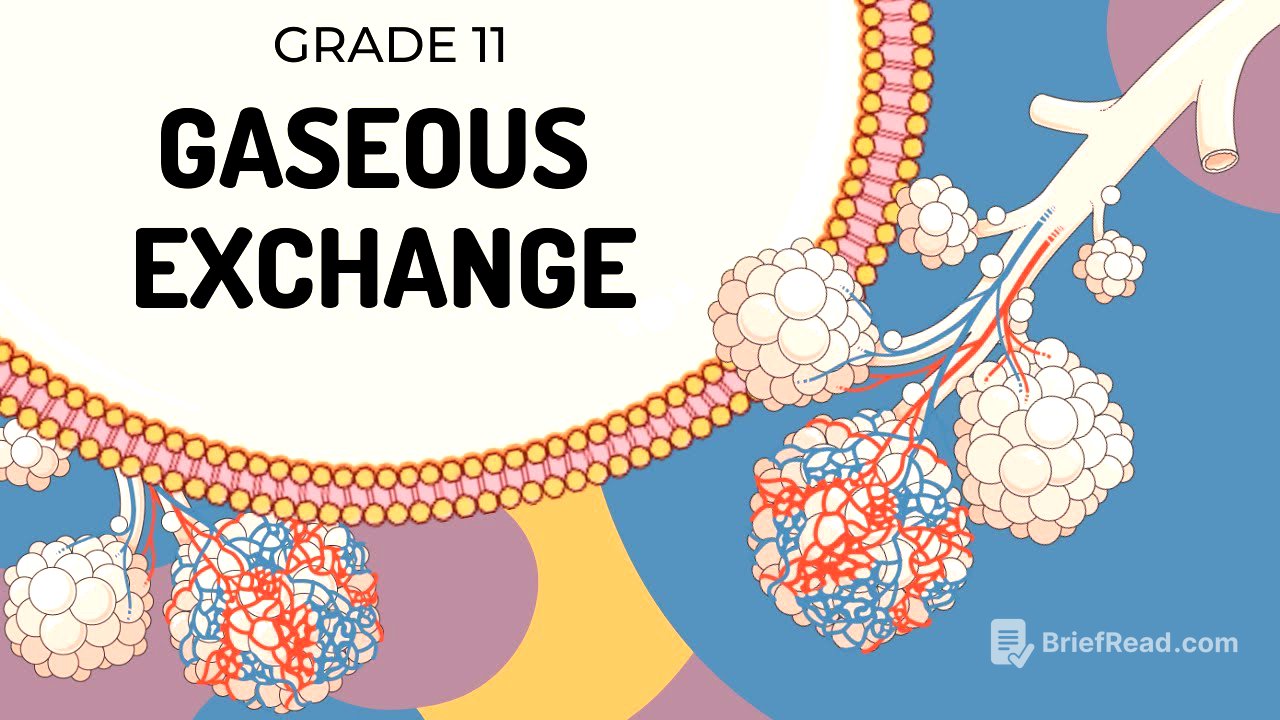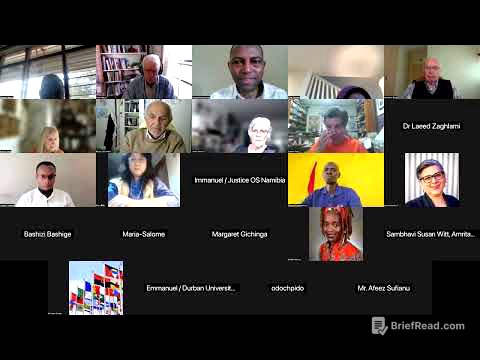TLDR;
This video explains the process of gaseous exchange in the human body, starting from the alveoli in the lungs to the tissues. It covers the conditions necessary for efficient gas exchange, the mechanics of air movement in the lungs (tidal air and residual volume), and the roles of partial pressure and concentration gradients. The video also details how oxygen and carbon dioxide are transported in the blood, including the three methods of carbon dioxide transport, and the importance of acidosis in facilitating oxygen release at the tissues.
- Six conditions necessary for efficient gas exchange.
- Tidal air and residual volume in lungs.
- Three ways of carbon dioxide transportation.
- Role of acidosis in oxygen release.
Intro [0:00]
Miss Angler introduces a lesson on gaseous exchange, tracing gases from the alveoli to the tissues. The video will cover how gases move through the blood, how they are transported, and how gaseous exchange occurs at the tissues. She encourages viewers to like the video, subscribe for more content, and consider joining her membership for additional resources.
Conditions for Successful Gaseous Exchange [0:54]
For gaseous exchange to be successful, six conditions must be present to ensure it is as functional and optimum as possible. These include a large surface area (provided by the alveoli), being well-ventilated (achieved by intercostal muscles and the diaphragm), a rich supply of blood vessels (a capillary network), a thin gaseous exchange surface (alveoli are one cell layer thick), being well-protected (pleural membrane and ribs), and being permanently moist (to facilitate diffusion).
Gaseous Exchange at the Alveoli [2:11]
The alveoli, located at the end of the bronchioles, are structured to maximise surface area for efficient gas exchange. Air entering the lungs as tidal air only reaches about halfway down the bronchi, with the remaining distance covered by diffusion from high to low concentration. Tidal air refers to the air flowing in and out of the lungs, while residual volume is the air that remains in the lungs to prevent them from collapsing, making it easier to inhale. Fresh air mixes with this residual volume, allowing gases to diffuse down to the alveoli.
Partial Pressure [5:39]
Partial pressure is a key factor in gaseous exchange, where each gas follows its own pressure gradient. Oxygen and carbon dioxide have different concentration gradients, with oxygen concentration being higher in inhaled air than carbon dioxide. Partial pressure refers to the individual pressure exerted by each gas as part of the total gas pressure in the lungs, enabling gases to flow according to their concentration gradients.
Gas Exchange Process [7:02]
Oxygen diffuses into the moisture lining of the alveoli, then across the alveolar lining, into the endothelium of the capillary, and finally into the red blood cells. Simultaneously, carbon dioxide moves from the red blood cells through the endothelium, into the alveolar lining and moisture, before evaporating into the alveolus to be exhaled. This exchange is vital, with gases dissolving into liquids and diffusing across membranes.
Transportation of Gases [9:46]
Red blood cells, or erythrocytes, use haemoglobin to pick up oxygen in the lungs and transport it to the body's tissues, forming oxyhaemoglobin. Carbon dioxide transport is more complex, occurring in three ways: combining with water to form bicarbonate ions (the most common method), combining with haemoglobin in small amounts, and dissolving in the cytoplasm of red blood cells to form carbonic acid.
Carbon Dioxide Transportation Methods [11:20]
Carbon dioxide is transported from the cells to the lungs via three methods. It can combine with water in the bloodstream to form bicarbonate ions, a more stable and alkaline substance. A small amount combines with haemoglobin, but this is limited to ensure oxygen can still bind effectively. Finally, carbon dioxide dissolves in the cytoplasm of red blood cells, forming carbonic acid, which is important for gaseous exchange despite being an acid.
Gaseous Exchange at the Tissues [13:04]
At the tissues, oxygen diffuses out of the bloodstream and into the cells, while carbon dioxide moves from the cells into the bloodstream, following concentration gradients. This exchange is influenced by partial pressure, with each gas exerting a part of the total gaseous pressure. The differences in gas concentrations encourage the exchange, ensuring oxygen is delivered to the tissues and carbon dioxide is removed as waste.
State of Acidosis [15:33]
Acidosis, a slightly acidic pH in the blood, is crucial for oxygen to detach from haemoglobin and enter the tissues. As carbon dioxide leaves the tissues and enters the bloodstream, it forms carbonic acid, lowering the pH. This acidity weakens the bond between oxygen and haemoglobin, allowing oxygen to be released into the cells while carbon dioxide is picked up for transport to the lungs.
Terminology Recap [18:07]
The lesson concludes with a review of key terminology, including alveoli (the site of gaseous exchange), tidal air (air flowing in and out of the lungs), residual volume (air remaining in the lungs), diffusion (movement from high to low concentration), capillaries (thin blood vessels around alveoli), erythrocytes (red blood cells), endothelial and epithelial cells (lining cells with moisture), haemoglobin (oxygen-carrying pigment), bicarbonate ions (transport form of carbon dioxide), and carbonic acid (important for acidosis).









